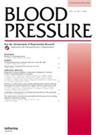Higher pulse pressure/stroke volume index is associated with impaired outcome in hypertensive patients with left ventricular hypertrophy the LIFE study
IF 2.3
4区 医学
Q2 PERIPHERAL VASCULAR DISEASE
引用次数: 16
Abstract
Abstract We tested the prognostic impact of a marker of arterial stiffness, pulse pressure/stroke volume index (PP/SVi), in patients with hypertension and left ventricular (LV) hypertrophy. We used data from 866 patients randomized to losartan or atenolol-based antihypertensive treatment, over a median of 4.8 years, in the Losartan Intervention For Endpoint reduction in hypertension (LIFE) study. The association of PP/SVi with outcomes was tested in Cox regression analyses and reported as hazard ratio (HR) and 95% confidence intervals (CI). In multivariate regression, reduction of PP/SVi was independently associated with male gender, reduction in systolic blood pressure (BP) and relative wall thickness and with an increase in left ventricular ejection fraction (all p < .05). After adjusting for confounders, higher baseline PP/SVi predicted a 38% higher hazard of combined major fatal and non-fatal cardiovascular events (95% CI 1.04–1.84), and higher hazard of cardiovascular mortality (HR 2.35 (95% CI 1.59–3.48) and stroke (HR 1.45 (95% CI 1.06–1.99) (all p < .05). Higher PP/SVi also predicts higher rate of hospitalization for HF (HR 2.15 (95% CI 1.48–3.12) and a 52% higher hazard of all-cause mortality (95% CI 1.10–2.09) (both p < .05). In hypertensive patients with electrocardiographic LV hypertrophy, higher PP/SVi was associated with increased cardiovascular morbidity and mortality.高脉压/卒中容量指数与左心室肥厚高血压患者预后受损相关
摘要:我们测试了动脉硬度指标脉压/脑卒中容积指数(PP/SVi)对高血压和左心室肥厚患者预后的影响。在氯沙坦干预降低高血压终点(LIFE)研究中,我们使用了866名随机接受氯沙坦或阿替洛尔为基础的抗高血压治疗的患者的数据,中位时间为4.8年。在Cox回归分析中检验了PP/SVi与结果的关联,并以风险比(HR)和95%置信区间(CI)报告。在多元回归中,PP/SVi的降低与男性、收缩压(BP)和相对壁厚的降低以及左心室射血分数的增加独立相关(均p < 0.05)。在调整混杂因素后,较高的基线PP/SVi预测合并主要致命性和非致命性心血管事件的风险增加38% (95% CI 1.04-1.84),心血管死亡率(HR 2.35 (95% CI 1.59-3.48)和卒中(HR 1.45 (95% CI 1.06-1.99)的风险增加(均p < 0.05)。较高的PP/SVi也预示着较高的HF住院率(HR 2.15 (95% CI 1.48-3.12)和高52%的全因死亡风险(95% CI 1.10-2.09) (p均< 0.05)。在伴有心电图左室肥厚的高血压患者中,较高的PP/SVi与心血管发病率和死亡率增加相关。
本文章由计算机程序翻译,如有差异,请以英文原文为准。
求助全文
约1分钟内获得全文
求助全文
来源期刊

Blood Pressure
医学-外周血管病
CiteScore
3.00
自引率
5.60%
发文量
41
审稿时长
6-12 weeks
期刊介绍:
For outstanding coverage of the latest advances in hypertension research, turn to Blood Pressure, a primary source for authoritative and timely information on all aspects of hypertension research and management.
Features include:
• Physiology and pathophysiology of blood pressure regulation
• Primary and secondary hypertension
• Cerebrovascular and cardiovascular complications of hypertension
• Detection, treatment and follow-up of hypertension
• Non pharmacological and pharmacological management
• Large outcome trials in hypertension.
 求助内容:
求助内容: 应助结果提醒方式:
应助结果提醒方式:


